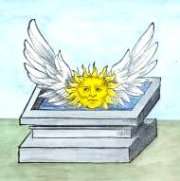Winged sun

The winged sun is a symbol associated with divinity, royalty and power in the Ancient Near East (Egypt, Mesopotamia, Anatolia, and Persia).
Ancient Egypt
In Ancient Egypt, the symbol is attested from the Old Kingdom (Sneferu, 26th century BC), often flanked on either side with a uraeus. In early Egyptian religion, the symbol Behedeti represented Horus of Edfu, later identified with Ra-Harachte. It is sometimes depicted on the neck of Apis, the bull of Ptah. As time passed (according to interpretation) all of the subordinated gods of Egypt were considered to be aspects of the sun god, including e.g. Khepri.
Mesopotamia and the Levant

From roughly 2000 BC, the symbol spread to the Levant and to Mesopotamia. It appears in reliefs with Assyrian rulers and in Hieroglyphic Anatolian as a symbol for royalty, transcribed into Latin as SOL SUUS (literally, "his own self, the Sun", i.e., "His Majesty").
Hebrew
From ca. the 8th century BC, the winged solar disk appears on Hebrew seals connected to the royal house of the Kingdom of Judah. Many of these are seals and jar handles from Hezekiah's reign, together with the inscription l'melekh ("belonging to the king").[1] Typically, Hezekiah's royal seals feature two downward-pointing wings and six rays emanating from the central sun disk, and some are flanked on either side with the Egyptian ankh ("key of life") symbol.[1] Prior to this, there are examples from the seals of servants of king Ahaz and of king Uzziah.[2]
Compare also Malachi 4:2, referring to a winged "Sun of righteousness",
- But unto you that fear my name shall the Sun of righteousness arise with healing in his wings... (KJV)
Zoroastrianism

The symbol evolved into the Faravahar (the "visual aspect of Ahura Mazda") in Zoroastrian Persia.
Greece
The winged sun is conventionally depicted as the knob of the Staff of Hermes.
Modern use

The symbol was used on the cover of Charles Taze Russell's textbook series Studies in the Scriptures beginning with the 1911 editions. Various groups such as Freemasonry, Theosophy, Rosicrucians and Unity Church have also used it. Variations of the symbol are used as a trademark logo on vehicles produced by the Chrysler Corporation, and Harley Davidson.
Heraldic use
A winged sun is used in the heraldry of the North America Trade Directory.[3]
Literature
- R. Mayer, Opificius, Die geflügelte Sonne, Himmels- und Regendarstellungen im Alten Vorderasien, UF 16 (1984) 189-236.
- D. Parayre, Carchemish entre Anatolie et Syrie à travers l'image du disque solaire ailé (ca. 1800-717 av. J.-C.), Hethitica 8 (1987) 319-360.
- D. Parayre, Les cachets ouest-sémitiques à travers l'image du disque solaire ailé, Syria 67 (1990) 269-314.
See also
References
- 1 2 Deutsch, Robert (July–August 2002). "Lasting Impressions: New bullae reveal Egyptian-style emblems on Judah's royal seals". Biblical Archaeology Review. 28 (4): 42–51. Retrieved 12 October 2014.
- ↑ Sarlo, Daniel (2014). "Winged Scarab Imagery in Judah: Yahweh as Khepri". Eastern Great Lakes Biblical Society Annual Meeting, Erie, PA. Retrieved 12 October 2014.
- ↑ Heraldic information of the North America Trade Directory (retrieved November 28, 2014)
External links
| Wikimedia Commons has media related to Winged sun. |
- Relief Depicting Gilgamesh Between Two Bull-Men Supporting a Winged Sun Disk, Kapara palace, Tell Halaf.
- Charles T. Russell's use of winged disk